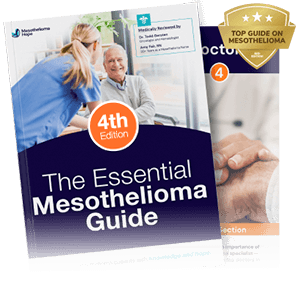What Causes Mesothelioma?
The only confirmed cause of malignant mesothelioma cancer is asbestos exposure. Asbestos is a naturally occurring mineral made up of strong, microscopic fibers.
Asbestos was commonly used in buildings, vehicles, and dozens of construction products from the 1930s to the early 1980s because it was cheap, durable, and resistant to fire, water, and sound. Makers of asbestos-based products knew the risks of exposure during this time but hid them from the general public.
If you or a loved one was diagnosed with mesothelioma, asbestos is likely the cause.
You can pursue medical care after a mesothelioma diagnosis and seek compensation from companies that used or made asbestos-containing goods without knowing the risks. Learn more with our Free Mesothelioma Guide.
Mesothelioma Risk Factors
There are several factors that may put individuals at a higher risk of mesothelioma than others.
Potential mesothelioma risk factors include:
- History of asbestos exposure: You may be more likely to develop mesothelioma if you regularly worked around or handled asbestos-based products.
- Family history: If a relative developed mesothelioma or another asbestos-related disease (such as lung cancer), you may also be at risk as you may have suffered secondhand asbestos exposure.
- Genetic mutation: According to the National Cancer Institute (NCI), a mutation in the BAP1 gene can increase the chances of developing mesothelioma tumors.
Registered Nurse Amy Fair discusses how exposure to asbestos can cause mesothelioma. View Transcript.
Duration: 1 min 06 sec
What are the causes of mesothelioma?
Many times after being diagnosed with mesothelioma your physician may ask you if you have been exposed to asbestos. Asbestos is a causative factor for mesothelioma. Some of the imaging studies may show underlying pleural plaques which are indicated that they have been around asbestos and may show underlying asbestosis.
The risk factors for developing mesothelioma are working around asbestos-related products or being indirectly around those products such as secondhand exposures that are seen with wives that launder their loved ones’ clothes and have asbestos dust on them. So direct asbestos exposure, as well as indirect asbestos exposure, can be causative factors for mesothelioma.
If you have symptoms of mesothelioma or any asbestos-related disease, it’s important that you inform your doctor of your asbestos exposure so that appropriate testing can be done.
How Does Asbestos Cause Mesothelioma?
Those who work with or around asbestos products and inhale or swallow asbestos fibers can possibly develop mesothelioma decades later.
Asbestos fibers can get stuck in different parts of the body and cause different types of mesothelioma.
Asbestos fibers that stick to the lung lining (pleura) cause malignant pleural mesothelioma, while fibers that reach the abdomen lining (peritoneum) cause peritoneal mesothelioma.
Although rare, pericardial mesothelioma is caused by asbestos fibers irritating the lining of the heart (pericardium), and testicular mesothelioma is caused by fibers irritating the lining of the testes (tunica vaginalis).
Learn more about how mesothelioma develops from asbestos fibers.


- 1. Exposure Asbestos fibers are sent into the air through activities like mining, building renovation, and vehicle or ship maintenance.
- 2. Entry Fibers enter the body through small air passages when inhaled or swallowed and stick to the pleura, peritoneum, pericardium, or tunica vaginalis.
- 3. Irritation Once inside the body, the fibers inflame and scar healthy mesothelial cells (which are found in the body’s internal linings).
- 4. Cancer Growth After decades of causing irritation, asbestos fibers damage the DNA of healthy cells, leading to uncontrollable cancer cell growth.
Asbestos exposure can also cause lung cancer, a non-cancerous disease of the lung called asbestosis, and many other conditions.
Types of Asbestos Exposure Causing Mesothelioma
Millions of people have been exposed to asbestos-containing products, and exposure could occur in many ways.
Those who served in the U.S. military or industrial occupations before the early 1980s were at a higher risk of asbestos exposure.
Learn more about the different types of asbestos exposure below.
Occupational Asbestos Exposure
The National Organization for Rare Disorders (NORD) reports that occupational exposure is the most common way people come in contact with asbestos.
According to the Occupational Safety and Health Administration (OSHA), 27 million employees were exposed to asbestos fibers through high-risk workplaces between 1940 and 1979.
Worksites with a high risk of asbestos exposure include:
- Automobile assembly plants
- Chemical plants
- Coal and asbestos mines
- Construction sites
- Mining sites
- Power plants
- Shipyards
- Steel mills
Although the use of asbestos was greatly reduced in the 1980s after the dangers were widely publicized, the mineral has not been completely banned. Some of these work sites still cause asbestos exposure and mesothelioma even today.
According to OSHA, 1.3 million workers have been exposed to asbestos in the modern day.
Military Asbestos Exposure
The military heavily used asbestos to keep several types of structures flame-resistant and durable. Due to the large amounts of asbestos used by the military, 33% of mesothelioma patients today are U.S. veterans.
The U.S. military used asbestos in:
- Airplanes
- Bases & other buildings
- Ships
- Vehicles
The U.S. Navy used more asbestos than any other military branch. As a result, U.S. Navy veterans have the highest risk of developing mesothelioma.
Secondhand Asbestos Exposure
Individuals can also develop mesothelioma through secondary exposure. Family members and friends may have been indirectly exposed if someone worked around asbestos regularly. For example, workers could carry asbestos fibers back home on their clothes, skin, and hair.
“There is some evidence that family members of workers heavily exposed to asbestos face an increased risk of developing mesothelioma.”
– National Cancer Institute
Environmental Asbestos Exposure
According to the NCI, many people experience some level of asbestos exposure due to small amounts of fibers entering the air, water, and soil. This type of environmental exposure rarely results in the incidence of mesothelioma.
However, there are some places where asbestos exists in unusually high concentrations. For example, people living close to mines or asbestos deposits are at a greater risk of mesothelioma.
Learn more about how asbestos exposure occurs and get treatment for mesothelioma with our Free Mesothelioma Guide. Order now and we’ll ship the guide overnight to you.
How to Prevent Asbestos Exposure & Mesothelioma
There is no known cure and no way to prevent mesothelioma after asbestos exposure, but there are several steps you can take to avoid coming into contact with this deadly material.
Know the Dangers
Areas with a high concentration of asbestos can put you at risk of mesothelioma. Identifying these areas and knowing the dangers can help you prevent exposure.
Find out if you will come in contact with asbestos at your workplace. For example, some buildings still contain asbestos, which may pose a risk if the building is damaged or renovated.
Follow Safety Regulations
If your job involves working around asbestos, follow all guidelines to reduce your exposure risk.
Also, showering and changing clothes before leaving work can help protect your loved ones from secondhand exposure.
Take Precautions at Home
Many older homes may still contain asbestos, such as ones with popcorn ceilings. This can lead to direct asbestos exposure and a higher risk of developing mesothelioma.
If you have an older home, make sure to get it inspected. If the asbestos in your home poses a threat, consult a professional to have it removed. Never handle asbestos yourself.
Voice Your Concerns
Contact your employer or landlord if you are concerned about asbestos in the workplace or your home. They can contact an asbestos abatement specialist who can seal or remove the products and keep them safe.
Get Regular Check-Ups
If you believe you have been exposed to asbestos in the past, it is important to get regular physical exams to ensure you are healthy.
This is especially important if you show signs of mesothelioma, such as chronic cough, trouble breathing, digestive issues, etc. Early detection may improve your mesothelioma prognosis (health outlook) and help you get prompt treatment from an oncology (cancer) specialist.
Advocate for Asbestos Bans
Asbestos is still not completely banned in the United States. You can advocate for an asbestos ban by signing petitions that urge the U.S. Environmental Protection Agency (EPA) to take action or by calling your local congressperson to support laws that ban asbestos.
Learn More About Mesothelioma Causes & Get Help
Millions of people were exposed to asbestos without knowing the grave dangers. Manufacturers of asbestos-containing products hid the truth about the toxic effects from the public.
If you or a loved one developed mesothelioma caused by asbestos exposure, you might be entitled to financial compensation to help you pay for treatment to improve your life expectancy.
No matter where you are in your journey in the fight against mesothelioma, we can help you get the health care information you need.
Get our Free Mesothelioma Guide today to learn more.
Mesothelioma Causes FAQs
What is the main cause of mesothelioma?
The only known mesothelioma cause is asbestos exposure. Many people were exposed to this mineral as it was widely used from the 1930s until the early 1980s in buildings, construction materials, and hundreds of other products.
Old structures might still contain asbestos in the present day.
Due to the long latency period of asbestos, it can take anywhere from 10 to 50 years for mesothelioma symptoms to develop after exposure.
What causes mesothelioma besides asbestos?
There are no other known causes of mesothelioma besides asbestos exposure. However, experts continue to conduct cancer research to study other potential causes and risk factors of mesothelioma.
Can you get mesothelioma without asbestos exposure?
At this time, it’s believed that almost all mesothelioma cases stem from asbestos exposure.
However, cancer research and clinical trials are showing that some potential genetic factors can put people at a higher risk of developing mesothelioma.
Researchers continue to study other possible mesothelioma causes and treatment methods for those diagnosed.
How serious is one time asbestos exposure?
There is generally no safe level of asbestos exposure. According to the National Organization for Rare Disorders (NORD), some victims have developed asbestos-related diseases after only one instance of exposure.
That said, those at the greatest risk of mesothelioma were regularly exposed to asbestos over the course of several years, usually in the workplace or as part of their service in the military.
What should I do if I think I have mesothelioma?
Contact your doctor as soon as possible if you were exposed to asbestos and are showing symptoms of mesothelioma.
Some common symptoms of mesothelioma include:
- Chest pain
- Shortness of breath
- Weight loss
The only way to confirm you have mesothelioma is to get a biopsy. Getting an early diagnosis can help you access more mesothelioma treatment options before the cancer spreads to other internal organs.





